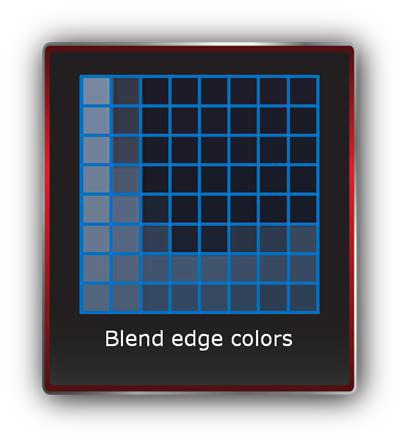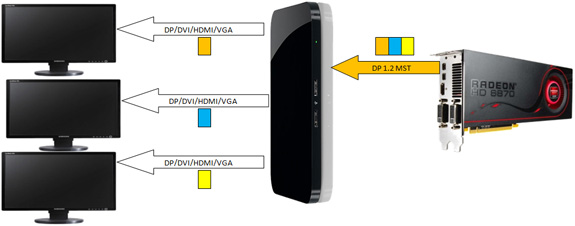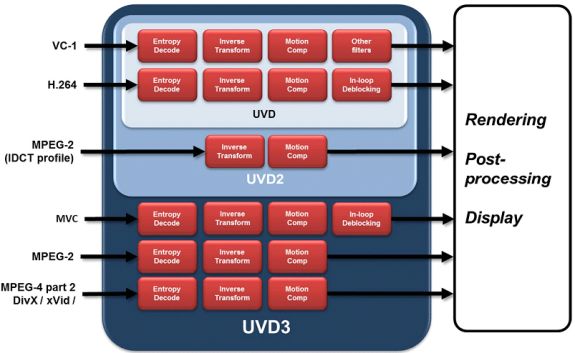AMD's Radeon HD 6970 & Radeon HD 6950: Paving The Future For AMD
by Ryan Smith on December 15, 2010 12:01 AM ESTRefresher: The 6800 Series’ New Features
Back in October AMD launched the first 6000 series cards, the Barts-based Radeon HD 6800 series. At their core they are a refreshed version of the Cypress GPU that we saw on the 5800 series, but AMD used the opportunity to make some enhancements over the standard Cypress. All of these enhancements apply throughout the 6000 series, so this includes the 6900 series. As such for those of you who didn’t pay much attention to the 6800 series, we’re going to quickly recap what’s new in order to lay the groundwork for further comparisons of the 6900 series to the 5800 series.
We’ll start with the core architecture. Compared to Cypress, Barts is nearly identical save 1 difference: the tessellator. For Barts AMD implemented what they call their 7th generation tessellator, which focused on delivering improved tessellation performance at lower tessellation factors that AMD felt were more important. Cayman takes this one step further and implements AMD’s 8th generation tessellator, which as the naming conventions implies is the 7th generation tessellator with even further enhancements (particularly those necessary for load balancing).
The second change we saw with Barts and the 6800 series was AMD’s refined texture filtering engine. AMD’s texture filtering engine from the 5800 set new standards by offering angle independent filtering, but it had an annoying quirk with highly regular/noisy textures where it didn’t do a good enough job blending together various mipmaps, resulting in visible transitions between them. For the 6800 series AMD fixed this, and it can now properly blend together noisy textures. At the same time in a controversial move AMD tweaked its default filtering optimizations for the 5800 series and entire 6000 series, leading to these cards producing imagines subtly different (and depending on who you ask, subtly worse) than they were on the 5800 series prior to the Catalyst 10.10 drivers.

| Radeon HD 5870 | Radeon HD 6870 | GeForce GTX 480 |
The third change we saw was the introduction of a new anti-aliasing mode, initially launched on the 6800 series and backported to the 5800 series shortly thereafter. Morphological Anti-Aliasing (MLAA) is a post-processing filter that works on any (and all) images, looking for high contrast edges (jaggies) and blending them to reduce the contrast. Implemented as a compute shader, it works with all games. As it’s a post-processing filter the results can vary – the filter has no knowledge of depth, polygons, or other attributes of the rendered world beyond the final image – so it’s prone to blending everything that looks like aliasing. On the plus side it’s cheap to use as it was originally designed for consoles with their limited resources, so by not consuming large amounts of memory & memory bandwidth like SSAA/MSAA it usually has a low performance hit.


Last but not least, AMD made a number of changes to their display hardware. The Universal Video Decoder (UVD) was upgraded to version 3, bringing full decode support for MPEG-2, MPEG-4 ASP, and H.264 MVC (packed frame video for 3D movies). For the 6900 series this is not of great importance as MPEG-2 and MPEG-4 ASP are low complexity codecs, but it does play an important role for AMD’s future APU products and low-end GPUs, where offloading these low complexity codecs is still going to be a big relief for the slower CPUs they’re paired with. And on that note the first public version of the DivX codec with support for UVD3 will be shipping today, letting 6800/6900 series owners finally take advantage of this functionality.
The second of the major display changes was the addition of support for the DisplayPort 1.2 standard. DP1.2 doubles DisplayPort’s bandwidth to 21.6Gbps, finally giving DisplayPort a significant bandwidth lead over dual-link DVI. With double the bandwidth it’s now possible to drive multiple monitors off of a single root DisplayPort, a technology called Multi Stream Transport (MST). AMD is heavily banking on this technology, as the additional bandwidth coupled with the fact that DisplayPort doesn’t require a clock source for each monitor/stream means AMD can drive up to 6 monitors off of a single card using only a pair of mini-DP ports. AMD is so cutting edge here that like the 6800 series the 6900 series is technically only DP1.2 ready – there won’t be any other devices available for compliance testing until 2011.

Finally, the 6800 series also introduced support for HDMI 1.4a and support for color correction in linear space. HDMI 1.4a support is fairly straightforward: the 6000 series can drive 3D televisions in either the 1080p24 or 720p60 3D modes. Meanwhile support for color correction in linear space allows AMD to offer accurate color correction for wide gamut monitors; previously there was a loss of accuracy as color correction had to be applied in the gamma color space, which is only meant for use for display purposes. This is particularly important for integrating wide gamut monitors in to traditional gamut workflows, as sRGB is misinterpreted on a wide gamut monitor without color correction.
While all of these features were introduced on the 6800 series, they’re fundamental parts of the entire 6000 series, meaning they’re part of the 6900 series too. This provides us with a baseline set of improvements over AMD’s 5800 series, on top of the additional improvements Cayman and AMD’s VLIW4 architecture brings.











168 Comments
View All Comments
mac2j - Wednesday, December 15, 2010 - link
Um - if you have the money for a 580 ... pick up another $80-100 and get 2 x 6950 - you'll get nearly the best possible performance on the market at a similar cost.Also I agree that Nvidia will push the 580 price down as much as possible... the problem is that if you believe all of the admittedly "unofficial" breakdowns ... it costs Nvidia 1.5-2x as much to make a 580 as it costs AMD to make a 6970.
So its hard to be sure how far Nvidia can push down the price on the 580 before it ceases to become profitable - my guess is they'll focus on making a 565 type card which has almost 570 performance but for a manufacturing cost closer to what a 460 runs them.
fausto412 - Wednesday, December 15, 2010 - link
yeah. AMD let us down on this here product. We see what gtx580 is and what 6970 is...i would say if you planning to spend 500...the gtx580 is worth it.truepurple - Wednesday, December 15, 2010 - link
"support for color correction in linear space"What does that mean?
Ryan Smith - Wednesday, December 15, 2010 - link
There are two common ways to represent color, linear and gamma.Linear: Used for rendering an image. More generally linear has a simple, fixed relationship between X and Y, such that if you drew the relationship it would be a straight line. A linear system is easy to work with because of the simple relationship.
Gamma: Used for final display purposes. It's a non-linear colorspace that was originally used because CRTs are inherently non-linear devices. If you drew out the relationship, it would be a curved line. The 5000 series is unable to apply color correction in linear space and has to apply it in gamma space, which for the purposes of color correction is not as accurate.
IceDread - Wednesday, December 15, 2010 - link
Yet again we do not get to see hd 5970 in crossfire despite it being a single card! Is this an nvidia site?Anyway, for those of you who do want to see those results, here is a link to a professional Swedish site!
http://www.sweclockers.com/recension/13175-amd-rad...
Maybe there is some google translation available or so if you want to understand more than the charts shows.
medi01 - Wednesday, December 15, 2010 - link
Wow, 5970 in crossfire consumes less than 580 in SLI.http://www.sweclockers.com/recension/13175-amd-rad...
ggathagan - Wednesday, December 15, 2010 - link
Absolutely!!!There's no way on God's green earth that Anandtech doesn't currently have a pair of 5970's on hand, so that MUST be the reason.
I'll go talk to Anand and Ryan right now!!!!
Oh, wait, they're on a conference call with Huang Jen-Hsun.....
I'd like to note that I do not believe Anadtech ever did a test of two 5970's, so it's somewhat difficult to supply non-existent into any review.
Ryan did a single card test in November 2009.That is the only review I've found of any 5970's on the site.
vectorm12 - Wednesday, December 15, 2010 - link
I was not aware of the fact that the 32nm process had been canned completely and was still expecting the 6970 to blow the 580 out of the water.Although we can't possibly know and are unlikely to ever find out what cayman at 32nm would have performed like I suspect AMD had to give up a good chunk of performance to fit it on the 389mm^2 40nm die.
This really makes my choice easy as I'll pickup another cheap 5870 and run my system in CF.
I think I'll be able to live with the performance until the refreshed cayman/next gen GPUs are ready for prime time.
Ryan: I'd really like to see what ighashgpu can do with the new 6970 cards though. Although you produce a few GPGPU charts I feel like none of them really represent the real "number-crunching" performance of the 6970/6950.
Ivan has already posted his analysis in his blog and it seems like the change from LWIV5 to LWIV4 made a negligible impact at the most. However I'd really love to see ighashgpu included in future GPU tests to test new GPUs and architectures.
Thanks for the site and keep up the work guys!
slagar - Wednesday, December 15, 2010 - link
Gaming seems to be in the process of bursting its own bubble. Graphics of games isn't keeping up with the hardware (unless you cound gaming on 6 monitors) because most developers are still targeting consoles with much older technology.Consoles won't upgrade for a few more years, and even then, I'm wondering how far we are from "the final console generation". Visual improvements in graphics are becoming quite incremental, so it's harder to "wow" consumers into buying your product, and the costs for developers is increasing, so it's becoming harder for developers to meet these standards. Tools will always improve and make things easier and more streamlined over time I suppose, but still... it's going to be an interesting decade ahead of us :)
darckhart - Wednesday, December 15, 2010 - link
that's not entirely true. the hardware now allows not only insanely high resolutions, but it also lets those of us with more stringent IQ requirements (large custom texture mods, SSAA modes, etc) to run at acceptable framerates at high res in intense action spots.